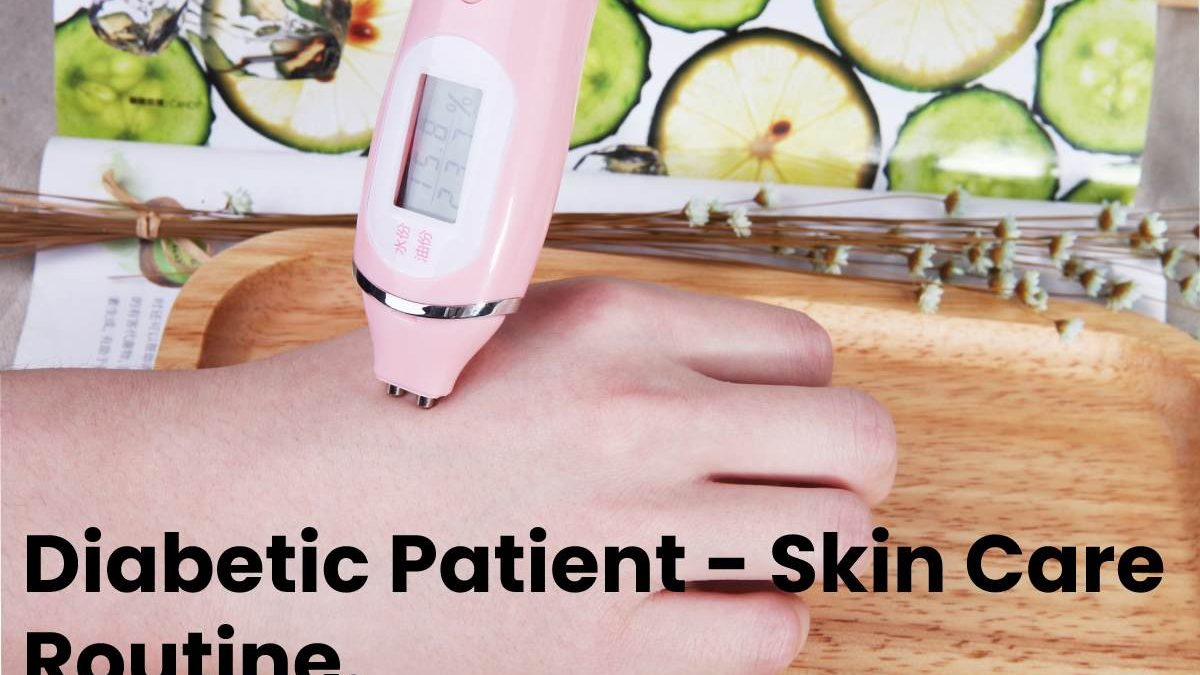Table of Contents
Introduction
Diabetic Patient – Skin Care Routine – Many people with diabetic patients have dry skin problems. This problem is more common in people with poorly controlled diabetes because when you have high blood sugar, your body “takes up water,” causing you to urinate more. The DIabetic patient’s skin becomes dehydrated. The skin can also be drier due to circulatory failure or damage to the nervous system, which can cause a decrease in the glands responsible for sweating. Finally, other factors not specific to the diabetic person, such as exposure to the sun and irritating or perfumed products, can contribute to skin drying.
Rash Related to Diabetic Patient and other Skin Conditions
Diabetic patients are at risk of skin rashes, such as acanthosis nigricans. High blood sugar is often the culprit. A rash can also be a mark of prediabetes. Many diabetic rashes go away once blood sugar levels are under control. Proper diabetes control and skincare can prevent skin problems that lead to severe infections.
What is Diabetes Rash?
Diabetes disturbs various portions of your body, including your skin. One in three people with diabetes (type 1 or type 2) will probably develop a rash or other skin problem. When you have diabetes, your chances of getting dry, itchy skin are higher than people without the disease. You’re also more likely to have other diabetes-related skin conditions.
What Causes a Diabetic Rash – Diabetic Patient?
Non-diabetic patients, a rash may be the first sign of high blood sugar (hyperglycemia) or prediabetes. If you take diabetes medications, a rash may indicate that you need to adjust treatments to lower blood sugar (glucose) levels. Some other rashes result from reduced blood flow to the extremities (hands and feet). Your health care provider can help you take steps to prevent diabetes.
How Can I Prevent Skin problems Related to diabetic Patient?
The excellent thing you can do to stop skin problems is keep your blood sugar levels within the range recommended by your healthcare provider. Proper skin care can reduce the risk of rashes, infections, or hard-to-heal wounds.
What does a Diabetic Patient’s Rash look like?
Diabetic rashes look different depending on the type and cause. Some diabetes-related rashes only affect people with diabetes. It usually goes away when your blood sugar is checked. These rashes include:
Blisters (diabetic blisters)
Painless blisters can form on the back of the hands and feet and the legs and forearms. This rare condition most commonly affects people with diabetic neuropathy.
Diabetic Skin Disease
Round, light brown, scaly patches appear on pimples that resemble age spots. These harmless spots do not require treatment.
Digital Sclerosis
Some people with type 1 diabetes develop hard, thick, waxy skin on the backs of their hands. As a result, the finger joints are stiff, making it difficult to move. A related rash is Bushke’s scleredema adult, tightening, thickening, and hardness of the back, neck, shoulders, and face. There are a variety of treatments that a dermatologist can offer.
Diabetic Patient Lipid Necrosis (DNL)
This rash on the lower leg is more common in women. NLD causes raised bright red patches with a yellow centre. Blood vessels may be more visible. The rash can be itchy and painful. It would be best if you debated your treatment options with your dermatologist.
Diabetic Patient Foot Syndrome
Other conditions can affect anyone but are especially common in people with diabetes. For example, ulcers can take a long time to settle and increase the risk of infection. The disease-causing these rashes can also be a warning sign of prediabetes.
Acanthosis Nigricans (AN)
This condition causes dark, velvety bands of discoloured skin. It usually affects people who are overweight/obese.
Disseminated Granuloma Annulare
Granuloma annulare often disturbs healthy kids and young adults. In diabetes, widespread granulomas annular form rings or arches on the fingers, hands, feet, and ears. The rash may be red, reddish-brown, or pigmented. It doesn’t cause pain, but it can sting. In many cases, it heals without treatment. However, if the area of involvement is small, topical steroids may be helpful in treatment.
Eruptive Xanthomatosis
Hard, yellow, pea-sized bumps on the itchy and red skin. This rash most commonly affects the hands, feet, arms, legs, and buttocks. It is more common in men with high cholesterol levels than in type 1 diabetes.
Vitiligo
People with type one diabetes are more susceptible to this skin condition. It causes loss of skin pigment, the substance that gives skin its colour. As a result, some people notice that they have light or white patches on their skin. Rarely itching or pain. Treatment includes corticosteroid creams, laser therapy, and phototherapy.
Skin Tags
These are small brown lumps on the skin, often located on the eyelids, neck, armpits, or groin. They are frequently asymptomatic and do not need treatment.
Lichen Planus
The lichen planus rash is characterized by itchy, purple bumps on the skin, sometimes with a white lace pattern. It usually appears on the ankles and wrists but can sometimes be seen in the mouth. There are many treatments available topically and in pill form that can be used to treat this problem.
Acquired Reactive Collagen Perforation Disease (ARPC)
It is common in patients with kidney failure in diabetic patients. The rash is usually a red, itchy bump. It can be treated with topical steroids, steroid injections into the inflammation, and other pills.
What other Skin Conditions Affect Diabetic Patients?
Diabetic Patients can have any skin form. However, sometimes people with diabetes get rashes or other skin irritations because of Allergic reactions: People with Diabetes can have an allergic reaction to oral diabetes medications.
To Avoid Skin Problems, Follow these steps:
- Check your skin daily for rashes, redness, and signs of infection or inflammation.
- When showering, use warm (not hot) water and moisturizing soap. (Soaking in the bathtub will dry out your skin.)
- Dry (do not rub) your skin with a towel. Check for folds of skin and between fingers and toes.
- After showering, apply an unscented moisturizer while your skin is still moist and soft. Look for creams and ointments (not lotions) that contain ceramides to help your skin retain moisture.
- Apply a cream containing 10-25% urea (emollient) to dry cracked heels at bedtime.
- Drink amply of water to prevent dehydration and keep your skin hydrated.
- Get hurt every day. Treat wounds and ulcers immediately with soap and water. Use antibiotic ointment only if your healthcare provider says it’s okay. Contact your healthcare provider if you see redness, pain, drainage, or signs of impurity.
8 Ways to Maintain Healthy Skin with Two Types Of Diabetes – Diabetic Patient
Try these strategies every day to keep your skin healthy.
1. Choose a gentle cleanser
2. Daily hydration
3. Don’t Scratch – Quiet
4. prevent clammy skin
5. prevent clammy skin
6. heal wounds as quickly as possible
7. blood sugar control
8. see a doctor
Tips to Prevent Dry Skin – Diabetic Patient
Maintain reasonable control of your diabetes by keeping your blood sugar regular
- Avoid boiling water, which promotes dry skin.
- Use a mild, unscented soap.
- Be sure to remove all traces of soap. Again, the shower is preferable to the bath to dislodge dirt or traces of soap.
- Dry the skin well by patting with a soft towel rather than rubbing vigorously.
- Too much cream can lead to Humidity Too much cream can lead to Excessive Humidity and, therefore, maceration of the skin.
- Contacting specific detergents or other chemicals can strip the skin’s natural oils. Therefore, it is advisable to dress gloves when handling these products.
- Physical activity stimulates the blood circuit, promotes diabetes control, and provides a feeling of well-being.
- Drink enough throughout the day.
Take a few extra precautions on sunny days – Diabetic Patient
- Avoid exposing yourself to the sun without protection, especially between 10 a.m. and 4 p.m.
- Apply sunscreen and lip balm with SPF Environment 30 minutes before Sun Water Exposure and Duis er Afterwards.
- Use water-repellent sunscreens.
- Beware of cloudy and windy days. The sun’s rays can pass through clouds and fog.
Conclusion
Diabetes increases the risk of rashes and skin problems. Therefore, it is significant to take care of your skin. A rash may symbolize that you need to change medications or dosages to control your blood sugar. Contact your doctor as soon as you notice a rash or anything that doesn’t look quite right. In addition, a good skincare routine can reduce the risk of diabetes-related skin problems.


